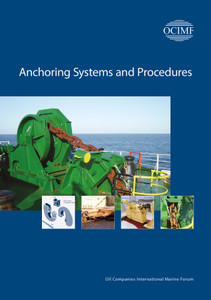
A practical and informative guide to modern anchoring equipment, seamanship practices and their associated problems.
This comprehensive guide to the principles and practices of anchoring covers all aspects of modern anchoring, looking at anchor types and design, the chain (including chain damage and loss), the effects of wind, and anchor operation. It also outlines common problems encountered when anchoring and their solutions, and assist the user in choosing the correct anchor, and anchoring operation, for every situation.
It is important to remember the wide scope of ships that sail the ocean today when considering anchors and anchor work. The anchors of the past, with their cables, windlasses and auxiliary equipment, were designed for ships to a limited tonnage and, within certain specifications regarding weather and bottom conditions, they were generally adequate. Today’s ships are considerably larger and, although the weights and sizes of the ground equipment have not been scaled to match, we still seem to expect the same performance from our anchor equipment. As this is not possible on very large vessels we must change our ideas and expectations of our anchors and adjust our seamanship methods to cope. Always remember that an anchor is designed for one purpose, to temporarily hold the ship in position while waiting for a berth or pilot. Everything else it may do is a bonus.
It cannot be long before more staff in port environmental positions begin to realise the extent of the problems with anchors on large ships and introduce regulations regarding the size of ships that can use certain anchorages, forcing larger ships out into deeper water and away from the coastlines. The problem with this happening lies in the holding power of the anchors and the capability of windlasses. Few ships carry sufficient cable to anchor securely and safely in deep water and many ships do not have windlasses with the power to lift the anchor from such depths.
Anchor Types
Testing the Anchors
Anchor Design
Anchor and Chain Damage and Loss
The Holding Power of Anchors
The Chain
Shackles and Joining Gear
The Windlass
The Wind and Current Effect
Wind/Current Forces and Holding Powers
Anchorages
Manoeuvrability
Anchorage Types
Positioning
Responsibilities in Anchorages
Approach to the Anchorage
Choosing the Anchor Position
Methods of Anchoring and Mooring
Anchoring to a Single Anchor
Which Anchor?
Using Both Anchors
After Anchoring
The Anchor watch
Mooring
Standing Moor
Running Moor
Berthing Using Anchors
Manoeuvring with Anchors
Large Vessels
Hanging off an Anchor
When the Anchor Drags
Ground Tackle Maintenance
Anchor Markings
Heaving Anchor
Conclusion
Anchoring Terms
References
Witherbys
Witherbys titles are developed using scripts developed by technical experts that are peer reviewed within work groups. Typically, they seek to improve understanding of the regulations, recommendations and guidelines issued by Industry.
Witherbys staff have significant expertise in the fields of navigation and hazardous cargoes as well as in the presentation of complex subjects in a graphic and easy to understand manner.
- Number of Pages:
- 86
- ISBN:
- 9781905331451
- Published Date:
- July 2009
- Binding Format:
- Paperback
- Book Height:
- 180 mm
- Book Width:
- 120 mm
- Weight:
- 0.2 kg
- Author:
Michael Lloyd
- Preview:
- Yes






